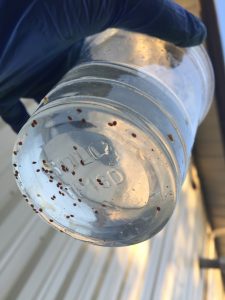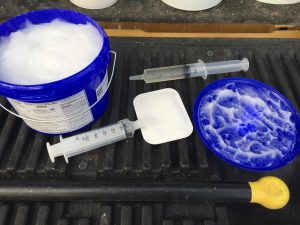Did you battle varroa mites this year? How well did you do? Did you win or lose?
Our 2016 varroa management strategy was simple. We were going to treat, treat, and treat some more. Here was our treatment plan.
- Treat in the Spring.
- Treat all new packages with one oxalic acid vaporization after being hived but before brood was laid.
- Treat all over wintered hives before they build up to far with oxalic acid vaporization three times 7-9 days apart.
- Treat in the late Summer (after honey harvest)
- Treat all hives with oxalic acid vaporization three times 7-9 days apart.
- Treat if necessary in the Fall.
- Treat again with oxalic acid vaporization, apiguard, or apivar depending on the weather.
- Treat with oxalic acid dribble if necessary.
We completed part one of the plan and we were in the clear. We did not see any queen problems caused by vaporization. We did have some slow queens and some that the bees did not like. They raised new ones and those hives went on to build up nicely (eventually). Most hives produced honey. Some that had queen issues did not produce much if missed their main flow. But by June, overall, our hives were stronger than ever. They were producing a good honey crop for us and appeared very healthy. We even had a visit from our local inspectors to see how we were doing and they found no problems and no mites when they tested.
When we completed part two in September we had harvested our main honey crop. A little bit of goldenrod honey was being made on our western bee yard. An exhausting summer was completed. We had just completed 6 mite treatments for the year. Maybe we were ahead of the curve.
 Reports started coming in about neighbors having very high mite counts. And not just a little high. They were astronomically high. Bee inspectors had diagnosed parasitic mite syndrome on entire apiaries not far from ours. All of those bees were going to be lost. At this point we were very worried about our bees and we decided to do some mite testing of our own. The samples we took were on the lower side (comparatively) in some of our bee yards. But in yards close to other problem sites the mite counts were extremely high. There were so many mites in the bottom of the test cup that we could not count them all.
Reports started coming in about neighbors having very high mite counts. And not just a little high. They were astronomically high. Bee inspectors had diagnosed parasitic mite syndrome on entire apiaries not far from ours. All of those bees were going to be lost. At this point we were very worried about our bees and we decided to do some mite testing of our own. The samples we took were on the lower side (comparatively) in some of our bee yards. But in yards close to other problem sites the mite counts were extremely high. There were so many mites in the bottom of the test cup that we could not count them all.
This is a bad situation. It is highly likely that our previously treated hives became mite infested by neighboring colonies with high counts. These mites were probably vectoring diseases and our hives were probably going to die. So what do do?
 Part of animal husbandry is taking proper care of the creatures that you are entrusted with – from life until death. Because of our duty, we decided to treat our bees even if they were eventually going to die. It was imperative that we do so right away. Even if they die or abscond it was important that we do not let any more mites out into the environment. These mites would endanger other neighboring colonies and these would become a victim like we were. This is being a good neighbor to our neighbors and our neighbor’s bees.
Part of animal husbandry is taking proper care of the creatures that you are entrusted with – from life until death. Because of our duty, we decided to treat our bees even if they were eventually going to die. It was imperative that we do so right away. Even if they die or abscond it was important that we do not let any more mites out into the environment. These mites would endanger other neighboring colonies and these would become a victim like we were. This is being a good neighbor to our neighbors and our neighbor’s bees.
So an emergency trip to Dadant was made and treatment products were purchased. Spacer boards and Apiguard (Thymol) was purchased for as many colonies as we could get product for. Everything else would get ApiVar (Amitraz). The treatments would be supplemented with oxalic acid dribble every 7-9 days.
 By the end of the season we had treated 9 or 10 times depending on how you calculate it. This is a lot of work to just try to save our bees from someone else’s lack of animal husbandry. It is also a lot of work to do when you are just going to lose a high percentage of the colonies anyway.
By the end of the season we had treated 9 or 10 times depending on how you calculate it. This is a lot of work to just try to save our bees from someone else’s lack of animal husbandry. It is also a lot of work to do when you are just going to lose a high percentage of the colonies anyway.
And lose colonies we did. All of the colonies that were near other high mite count apiaries ended up with high mite counts and mite related diseases. They all failed. These yards experienced 80% losses or more.
Overall our losses are at 50%. These types of losses do not make any kind of beekeeping operation sustainable. If a dairy operation lost half of its calves each year or half of its heifers it would be a disaster. The only reason why 50% losses for beekeeping is not taken notice by many is that the bees can be more resilient than the beekeeper under certain circumstances.
Lately, the majority of the beekeepers are failing their bees by not testing and treating for mites in a timely manner. This is a failure of the mission of animal husbandry. According to a recent article in Bee Culture Magazine, commercial beekeepers treat anywhere from 6-10 times or more a year. In contrast most small beekeepers do very little or nothing at all. (Kim Flottum Bee Culture Jan 2017)
The more articles that we read about varroa mites, the more they mention varroa bombs and describe the problems we are having. (Jerry Hayes, Randy Oliver American Bee Journal Vol. 157 No.1; Toni Burnham Bee Culture Jan 2017; Randy Oliver Vol. 156 No 12; Randy Oliver Vol. 156 No 11). We have been experiencing this for the last few seasons. Despite our treatments bees get reinfected and end up dying.
One lesson should be learned from all of this. No one beekeeper can keep bees alone or solve his or her mite problems by themself. Bees are social insects. Beekeepers need to be social and work together to fight the problem before all the gains we are making in beekeeping in our home towns are lost. Be a good beekeeper. Be a good neighbor.
We will be feeding pollen patties next week and starting to clean out dead outs. Hopefully the losses will not get any worse. By the time the replacement bees arrive, we need to have our mite management plan ready. Have you figured out your plan for 2017?